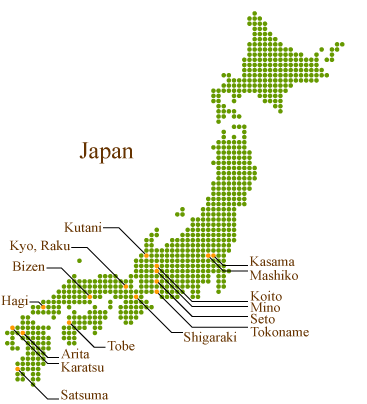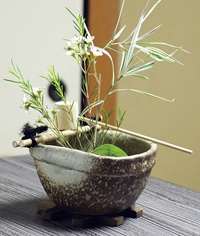Earthenware - Japanese Traditional Culture | Styles of Yakimono
Styles of Yakimono
There are various kinds of earthenware(called Yakimono), and they are made in various parts of Japan.
The main homes of them are shown in this figure.

◆Kasama-yaki: Produced in Ibaraki.
◆Mashiko-yaki: Produced in Tochigi.
◆Koito-yaki: Produced in Gifu.
◆Mino-yaki: Produced in Gifu. Includes Shino-yaki, Oribe-yaki, Setoguro, and Ki-Seto.
◆Seto-yaki: Produced in Aichi. The most produced Japanese pottery in Japan. Sometimes, the term Seto-yaki (or Seto-mono) stands for all Japanese pottery.
◆Tokoname-yaki: Produced in Aichi. Most are flower vases, rice bowls, teacup.
◆Shigaraki-yaki: Produced in Shiga. One of the oldest styles in Japan. Famous for tanuki pottery pieces.
◆Tobe-yaki: Produced in Shikoku. Most are thick porcelain table ware with blue cobalt paintings.
◆Arita-yaki (Imari-yaki): Produced in Saga.
◆Karatsu-yaki: Produced in Saga. The most produced pottery in western Japan. Believed to have started in the 16th century. Greatly influenced by Korean potters.
◆Satsuma-yaki: Produced in Kyūshū and other areas. Started by Korean potters about four hundred years ago.
◆Hagi-yaki: Produced in Yamaguchi. Since it is burned at a relatively low temperature, it is fragile and transmits the warmth of its contents quickly.
◆Bizen-yaki: Produced in Okayama. Also called Inbe-yaki. A reddish-brown pottery, which is believed to have originated in the 6th century.
◆Kyo-yaki: Produced in Kyoto.
◆Raku-yaki: Produced in Kyoto. There is a proverb of the hierarchy of ceramic styles used for tea ceremony: 'First, Raku(-yaki). Second, Hagi. Third, Karatsu.'
◆Kutani-yaki: Produced in Ishikawa.
Copyright© Earthenware All Rights Reserved.
